How is embossed printing done?
Embossed printing is a technique that adds texture and depth to printed materials, enhancing their visual appeal and making them stand out. This method is widely used in various industries such as business cards, invitations, packaging, and even book covers. But how is embossed printing done? Let's delve into the process and understand the steps involved.
What is Embossed Printing?
Embossed printing is a process that creates raised and recessed patterns or images on paper or other materials. It involves applying pressure on the material using either a male or female die, or both, which is created with the desired design. The pressure applied causes the material to deform, resulting in a raised pattern on one side and a recessed pattern on the other.

Designing the Die.
The first step in embossed printing is creating a die with the desired design. The die is typically made of metal, such as magnesium or copper, and is engraved with the pattern or image that is to be embossed. The design is usually provided by a graphic designer or produced through computer-aided design (CAD) software. The die is then transferred onto a metal plate, which serves as the stamping tool for the embossing process.
Preparing the Material.
Once the die is ready, the material to be embossed is prepared. This can be paper, cardstock, or other suitable materials. It is important to choose a material that can withstand the pressure applied during the embossing process without tearing or distorting. The material is trimmed to the desired size and thickness, and any existing print or coating on the surface is removed to ensure the best results.
Embossing the Material.
With the die and material prepared, it is time to begin the embossing process. The material is placed between the upper and lower plates of an embossing machine. The die, mounted on the male plate, is then pressed against the material with the pressure applied by the female plate. The combination of heat and pressure allows the die to transfer the embossed pattern onto the material, creating the desired raised and recessed effect.
Finishing Touches.
Once the embossing is complete, the material may undergo additional processes to enhance its appearance. This can include trimming any excess material, adding a protective coating, or applying additional finishing techniques such as foil stamping or spot UV coating. These finishing touches further enhance the visual impact of the embossed design.
In conclusion, embossed printing is a versatile technique that adds texture and depth to printed materials. From business cards to packaging, embossed printing can give any design a premium and professional appearance. By understanding the process of embossed printing, businesses and individuals can create visually stunning materials that leave a lasting impression.
If you are looking to incorporate embossed printing in your next project, do not hesitate to contact us. Our experienced team can help you bring your ideas to life and create eye-catching materials that will captivate your audience.
For more comic paperback book printing, cnprint, luxury hardcover book printinginformation, please contact us. We will provide professional answers.
146
0
0


Comments
All Comments (0)